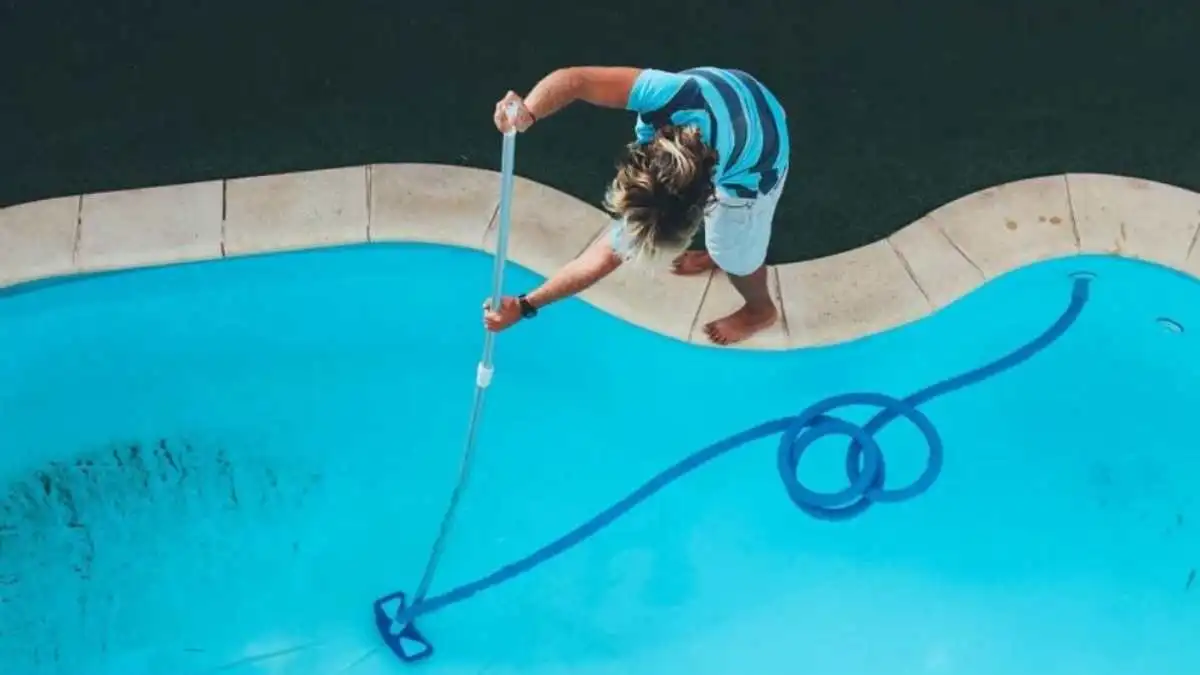GENERAL
What Chemical Is Used to Clean Pools?

Chemicals are the salt of the earth for maintaining a clean pool. Even though a robot pool cleaner is capable of cleaning debris and dirt that may accumulate on the pool surface, the chemical part of pool maintenance is critical for keeping water clear of irritating or unsafe materials. In this blog, we’ll look at the main chemicals in cleaning pools and how a pool vacuum, robotic pool cleaner, and other equipment help keep your pool in tip-top condition.
Chemicals and Their Effects on Pools
Robot pool cleaners assist with the mechanical cleansing of a pool by removing debris from the hot tub surface and the bottom of a hot tub. The pool chemicals protect your pool from harmful bacteria, algae, and other contaminants. These are the most frequently used pool cleaning chemicals and their functions:
Chlorine
The most widely used chemical for the maintenance of pools is chlorine for the disinfection of the water. It helps eliminate bacteria, viruses, and algae, allowing the water in the pool to be clean and safe. Chlorine is delivered in various forms (liquid, tablets, and granules). Regularly measuring the amount of chlorine in your swimming pool is essential to ensure the pool is sanitized. A pool cleaning robot like the Beatbot AquaSense 2 Pro can help you keep your pool clean but won’t keep the water free from germs.
pH Balancers
To maintain a neutral pH level, pool water should measure between 7.4 and 7.6 on the pH scale—neither too acidic nor too alkaline. PH balancers like sodium carbonate (also known as soda ash) and sodium bisulfate (dry acid) help balance pH levels. Too high or too low, and the pH can cause issues such as eye irritation or equipment corrosion. Using a pool vacuum robot or swimming pool robot cleaner often helps to remove dirt that can influence pH.
Algaecides
Algaecides are chemicals that help prevent or treat algae in your pool. Swimming Pool Maintenance Tip: While a pool robotic pool cleaner can remove some algae (especially small amounts), algaecides are required to control larger algae blooms. If you have an algae problem, you can treat the pool water with an algaecide before it escalates too much. Choosing the proper algaecide ( pool vacuum for algae, etc.) unique to your pool type also prevents algae strains that are more stable.
Shock Treatments
Occasionally, pools need something called “shock,” a heavy dose of chlorine or other disinfectants. When the pool water is very cloudy or the pool is highly contaminated, this is often used. More specifically, Shock Example 1 is for shocking the pool and helps eliminate unnecessary bacteria, algae, and organic matter for safe swimming. Maytronics pool cleaners or robot pool cleaners will only assist with the general cleaning of the pool when used regularly, but they don’t negate the need for shock treatments.
Cyanuric Acid (Stabilizer)
Cyanuric acid is a stabilizer that protects chlorine from getting destroyed by the sun’s ultraviolet (UV) rays. Chlorine can dissipate very quickly without cyanuric acid, rendering it less effective. It’s beneficial in outdoor pools where chlorine can evaporate more quickly. Specific vacuum cleaners for pool models can help with pool clarity, but you will still need cyanuric acid to help stabilize your chlorine levels.
The Role of Pool Robots in the Cleaning Process
Although chemicals do play a role in keeping both safe and clean with water, nothing does the dirty work quite like a robot pool cleaner such as the Beatbot AquaSense 2 or Beatbot iSkim Ultra. The best swimming pool robot cleaners keep a pool floor, a wall, and a waterline clean to prevent dirt and particles that can make pool water cloudy and produce algae growth. While they won’t disinfect your water or modify pH levels, they are integral to your pool maintenance toolkit.
One key benefit of using a robot pool cleaner is that it allows you to clean your pool without working hard.
How often you clean your pool depends on its size, how you use it, and the environmental conditions. Running a robot pool cleaner several times a week will keep the pool free from dirt and debris and reduce the need for a proper pool vacuum or skimmer. If you live somewhere with many trees or debris, a robot pool cleaner can still help make your life a lot easier by automating the job.
Pool Maintenance: Essential Tools
Besides robotic pool cleaners, you can get equipment like pool vacuum robots and wall-climbing pool cleaners to take your pool cleaning to the next level. These tools work alongside chemicals to keep a pool consistently clean. However, improved algae elimination for an above-ground pool and skimmer remove floating debris and leaves from the surface.
Conclusion
If your pool always needs to have debris removed due to its environment, then a robot pool cleaner would be an excellent solution for a cleaner pool. However, using pool chemicals is essential to maintain the proper water chemistry to keep the water safe and balanced. You ensure your pool stays healthy and clean by applying the right chemicals—chlorine, pH balancers, algaecides, and stabilizers. Combined with a robotic pool cleaner like the Beatbot AquaSense 2 Pro or Maytronics pool cleaner, you’re looking at a sparkling clean pool with the least effort.
Should you wish to read more, visit our blog page. We’ve got more topics for you!
-

 BIOGRAPHY7 months ago
BIOGRAPHY7 months agoBehind the Scenes with Sandra Orlow: An Exclusive Interview
-

 HOME1 year ago
HOME1 year agoDiscovering Insights: A Deep Dive into the //vital-mag.net blog
-

 HOME1 year ago
HOME1 year agoSifangds in Action: Real-Life Applications and Success Stories
-

 BIOGRAPHY1 year ago
BIOGRAPHY1 year agoThe Woman Behind the Comedian: Meet Andrew Santino Wife




























